- Back to Home »
- How to lose the post-baby bump
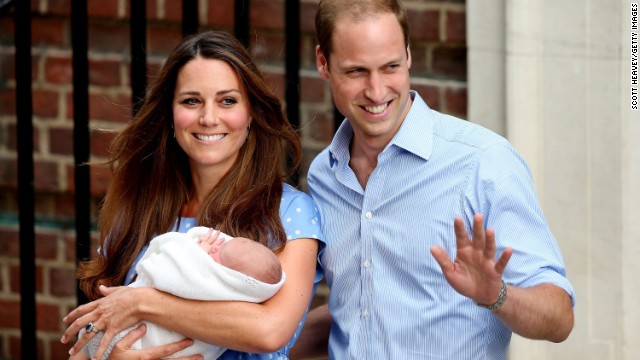 Prince William, Duke of Cambridge and Catherine, Duchess of Cambridge, depart St. Mary's Hospital with their newborn son on Tuesday, July 23, in London. The boy was born at 4:24 p.m. Monday, weighing 8 pounds, 6 ounces.
Prince William, Duke of Cambridge and Catherine, Duchess of Cambridge, depart St. Mary's Hospital with their newborn son on Tuesday, July 23, in London. The boy was born at 4:24 p.m. Monday, weighing 8 pounds, 6 ounces. 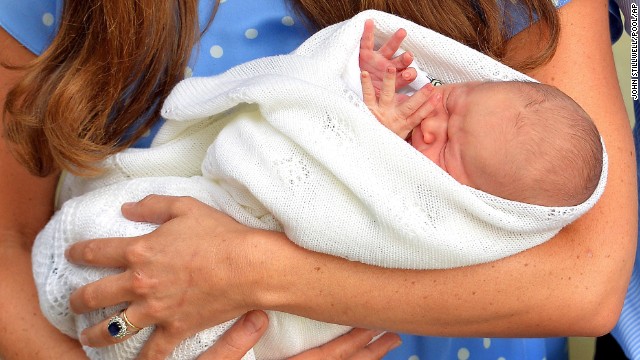 Catherine holds the baby outside the hospital for the public's first view.
Catherine holds the baby outside the hospital for the public's first view.  The new parents stand in front of the Lindo Wing of the hospital.
The new parents stand in front of the Lindo Wing of the hospital.  A Kensington Palace spokesman said: "Mother, son and father are all doing well this morning."
A Kensington Palace spokesman said: "Mother, son and father are all doing well this morning." 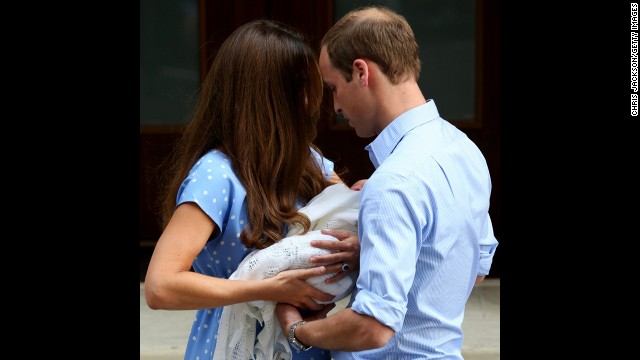 Catherine hands the baby off to William.
Catherine hands the baby off to William. 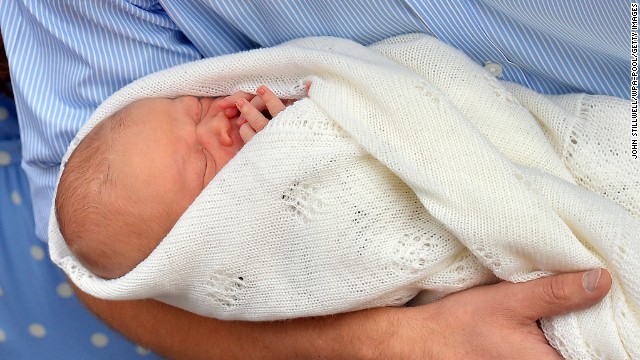 The couple is "still working on a name," William said, "so we'll have that as soon as we can." But he added, "He's got her looks, thankfully."
The couple is "still working on a name," William said, "so we'll have that as soon as we can." But he added, "He's got her looks, thankfully." 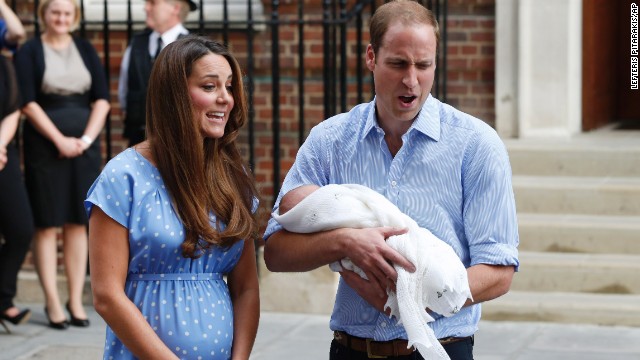 "It's very special," said William. The prince has already changed his first diaper, the couple told reporters.
"It's very special," said William. The prince has already changed his first diaper, the couple told reporters. 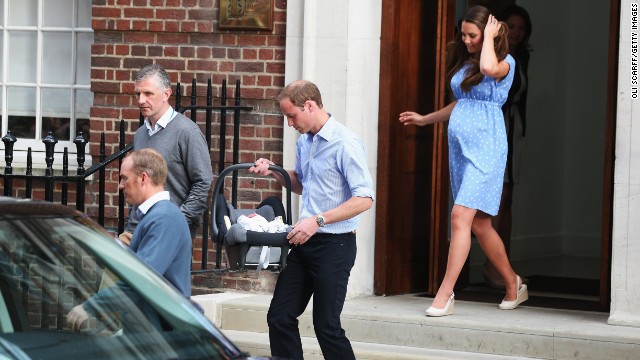 The new parents leave the hospital Tuesday evening with William carrying the boy out in a car seat and installing him in the back of a black SUV for the trip to Kensington Palace.
The new parents leave the hospital Tuesday evening with William carrying the boy out in a car seat and installing him in the back of a black SUV for the trip to Kensington Palace.  The newborn sits in his car seat for the ride home.
The newborn sits in his car seat for the ride home.  Prince William gets ready to depart St. Mary's Hospital.
Prince William gets ready to depart St. Mary's Hospital. 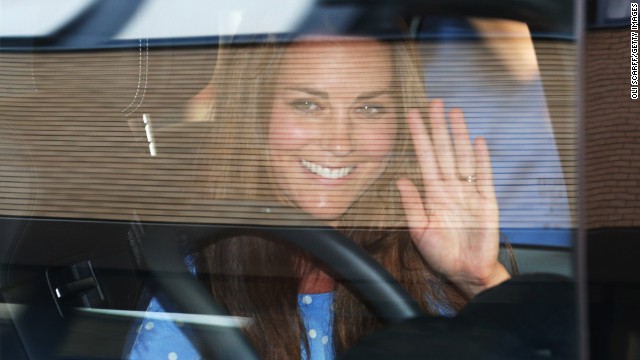 Catherine waves to the crowd gathered outside the hospital.
Catherine waves to the crowd gathered outside the hospital.  Well-wishers see the royal couple off after getting a glimpse of the newest heir to the British throne.
Well-wishers see the royal couple off after getting a glimpse of the newest heir to the British throne. 
1

2

3

4

5

6

7

8

9

10

11

12
- Women may need to wait six weeks after birth to exercise again
- Weight gained during pregnancy affects how long it will take to lose it
- There are some exercises mothers can do with their babies
(CNN) -- When the Duchess of Cambridge revealed her newborn son to the world, she also unashamedly showed off her prominent post-baby bump. Moms around the world praised her for not hiding what women's bodies look like after giving birth.
"Kate shows what a real mum looks like -- and natural is beautiful," Siobhan Freegard of the Netmums website told the Daily Mail.
Unlike many celebrities would lead us to believe, a woman rarely emerges from childbirth free of her extra pregnancy pounds. Even women who gained a healthy amount of weight during pregnancy will have some to lose after going home from the hospital, experts say.
Immediately after childbirth, the uterus is still the size it was when a 20-week fetus was inside, says Dr. Gregory Fountain, OB/GYN at Emory Johns Creek Obstetrics and Gynecology near Atlanta. It takes about six weeks for it to shrink down to its normal size, he says.
Women typically gain between 25 and 35 pounds during pregnancy, and a lot of it does come out during birth, Fountain says. Depending on the size of the baby, the amount of fluid and the weight of the placenta, the amount lost in childbirth generally equals 10 to 12 pounds.
 Prince meets the public
Prince meets the public But it's common these days for women to gain more weight than they should during pregnancy.
Fast facts about Duchess Catherine
Women who gain too much weight will, as you might imagine, need more time to lose the weight after the baby comes into the world, Fountain says. Everyone's metabolism is different, too, so that will play a role.
Doctors usually recommend women refrain from vigorous exercise until about least six weeks after delivery for noncomplicated vaginal and cesarean births, according to Fountain. Some women take longer, depending on the complexity of the delivery.
After giving birth to her first child, a woman will typically have a laceration, muscle injury or soft tissue swelling associated with the delivery that will take time to heal, Fountain says. He recommends walking as the main form of exercise during this time.
Talk to your doctor about what time frame is best for you, however. According to the Mayo Clinic, women who exercised during pregnancy and had an uncomplicated vaginal delivery may begin again as soon as they feel ready, even within days of delivery.
Stop the exercise that you're doing if you start to feel any pain, experts say.
A realistic goal for post-pregnancy weight loss is somewhere between three and six months, Fountain says, but that all depends on how motivated the woman is and how much time she has to devote to fitness.
There are activities built into motherhood that can help, however.
Breast-feeding burns about 500 calories a day, so it helps women lose weight faster than those who use formula, Fountain says. Some research has indicated physical activity can make breast milk taste sour because of an accumulation of lactic acid, according to the Mayo Clinic. This problem may be avoided by feeding the baby or pumping milk before a vigorous workout.
The baby can also help you stay fit, says Simone De La Rue, a fitness expert and trainer who has worked with celebrities and models.
"We always have a joke -- rather than lifting a 3-pound weight, you lift the baby," she says. Rocking or lifting the baby can be great for the biceps and upper body. Dancing with the baby can both soothe the baby and get you moving, too, De La Rue says.
You can also push the baby around in a stroller when you want to go for a walk, notes Desiree Nathanson, a fitness and nutrition expert in Atlanta.
Motivation is hard for new mothers; they're exhausted and often feel like they're the only ones going through this, De La Rue says. Joining forces with other moms can be a big help.
A look back at royal baby clothes
It's important to be patient and ignore tabloid reports of celebrities who instantly bounce back into shape after having a child, Nathanson says.
"It's going to take some time," she says. "It's just going to depend on your body, so you just have be patient and realize that you've just given birth to a human being and that's what you need to focus on."
New mothers also have a hard time fitting exercise into their routines of responsibilities of child care; don't feel pressure to find a large block of time, De La Rue says.
"It's hard to find an hour, so if you can find 10 minutes, do 10 minutes of arms or 10 minutes of cardio, and later on in the day when the baby is snoozing, you can try and take another 10 minutes for yourself," she recommends.
De La Rue tries to ease back into abdominal work with clients who have recently had babies since the area is still sensitive.
She starts them off with low-impact cardio to get the heart rate going, then moves into arms and legs. She often waits until four or five months after a client has had a baby to focus on abdominal work, just to make sure everything has healed.
The "plank" yoga position could be held while your baby is on the floor underneath you lying down, she says. You can try it on your elbows or hands, but if that's too difficult, try it on elbows and knees or hands and knees. Make sure your hips are slightly tilted back so that your abs are engaged and your shoulders are retracted.
Your lower back should also get some attention, Nathanson says. The ''Superman" or "swimmers" position, in which you lie on your stomach and lift your arms and legs a couple inches off the ground, will strengthen your back muscles.
Focusing on how awful you may think you look post-baby is counterproductive, Nathanson says.
"Try to stay positive, and move, and focus on the baby."







